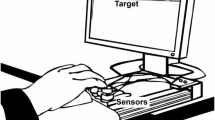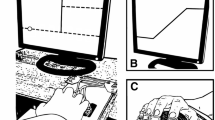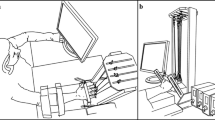Abstract
We explored the role of the basal ganglia in two components of multi-finger synergies by testing a group of patients with early-stage Parkinson’s disease and a group of healthy controls. Synergies were defined as co-varied adjustments of commands to individual fingers that reduced variance of the total force and moment of force. The framework of the uncontrolled manifold hypothesis was used to quantify such co-variation patterns, while average performance across repetitive trials (sharing patterns) was analyzed using the analytical inverse optimization (ANIO) approach. The subjects performed four-finger pressing tasks that involved the accurate production of combinations of the total force and total moment of force and also repetitive trials at two selected combinations of the total force and moment. The ANIO approach revealed significantly larger deviations of the experimental data planes from an optimal plane for the patients compared to the control subjects. The synergy indices computed for total force stabilization were significantly higher in the control subjects compared to the patients; this was not true for synergy indices computed for moment of force stabilization. The differences in the synergy indices were due to the larger amount of variance that affected total force in the patients, while the amount of variance that did not affect total force was comparable between the groups. We conclude that the basal ganglia play an important role in both components of synergies reflecting optimization of the sharing patterns and stability of performance with respect to functionally important variables.





Similar content being viewed by others
References
Bäckman L, Nyberg L, Lindenberger U, Li S-C, Farde L (2006) The correlative triad among aging, dopamine and cognition: current status and future prospects. Neurosci Biobehav Rev 30:791–807
Bernstein NA (1947) On the construction of movements. Medgiz, Moscow (in Russian)
Bertram CP, Lemay M, Stelmach GE (2005) The effect of Parkinson’s disease on the control of multi-segmental coordination. Brain Cogn 57:16–20
Bosco G, Poppele RE (2002) Encoding of hindlimb kinematics by spinocerebellar circuitry. Arch Ital Biol 140:185–192
Brown MJN, Almeida QJ (2011) Evaluating dopaminergic system contributions to cued pattern switching during bimanual coordination. Eur J Neurosci 34:632–640
Chowdhury R, Guitart-Masip M, Lambert C, Dayan P, Huys Q, Düzel E, Dolan RJ (2013) Dopamine restores reward prediction errors in old age. Nat Neurosci 16:648–653
Cisek P, Kalaska JF (2005) Neural correlates of reaching decisions in dorsal premotor cortex: specification of multiple direction choices and final selection of action. Neuron 45:801–814
Coltz JD, Johnson MTV, Ebner TJ (1999) Cerebellar Purkinje cell simple spike discharge encodes movement velocity in primates during visuomotor arm tracking. J Neurosci 19:1782–1803
Contreras-Vidal JL, Stelmach GE (1996) Effects of Parkinsonism on motor control. Life Sci 58:165–176
Danna-Dos-Santos A, Degani AM, Latash ML (2008) Flexible muscle modes and synergies in challenging whole-body tasks. Exp Brain Res 189:171–187
d’Avella A, Saltiel P, Bizzi E (2003) Combinations of muscle synergies in the construction of a natural motor behavior. Nat Neurosci 6:300–308
de Rugy A, Loeb GE, Carroll TJ (2013) Are muscle synergies useful for neural control? Front Comput Neurosci 7:19
Diedrichsen J, Shadmehr R, Ivry RB (2010) The coordination of movement: optimal feedback control and beyond. Trends Cogn Sci 14:31–39
Fahn S, Jankovic J (2007) Principles and practice of movement disorders. Elsevier, Philadelphia, PA
Forssberg H, Eliasson AC, Redon-Zouitenn C, Mercuri E, Dubowitz L (1999) Impaired grip-lift synergy in children with unilateral brain lesions. Brain 122:1157–1168
Fradet L, Lee G, Stelmach G, Dounskaia N (2009) Joint-specific disruption of control during arm movements in Parkinson’s disease. Exp Brain Res 195:73–87
Gelfand IM, Latash ML (1998) On the problem of adequate language in movement science. Mot Control 2:306–313
Georgopoulos AP, Kalaska JF, Caminiti R, Massey JT (1982) On the relations between the direction of two-dimensional arm movements and cell discharge in primate motor cortex. J Neurosci 2:1527–1537
Goodman SR, Latash ML (2006) Feedforward control of a redundant motor system. Biol Cybern 95:271–280
Houk JC (2005) Agents of the mind. Biol Cybern 92:427–437
Ivanenko YP, Poppele RE, Lacquaniti F (2004) Five basic muscle activation patterns account for muscle activity during human locomotion. J Physiol 556:267–282
Kaiser HF (1960) The application of electronic computers to factor analysis. Psychol Meas 20:141–151
Latash ML (2008) Synergy. Oxford University Press, NY
Latash ML (2010) Motor synergies and the equilibrium-point hypothesis. Mot Control 14:294–322
Latash ML (2012) The bliss (not the problem) of motor abundance (not redundancy). Exp Brain Res 217:1–5
Latash ML, Scholz JF, Danion F, Schöner G (2001) Structure of motor variability in marginally redundant multi-finger force production tasks. Exp Brain Res 141:153–165
Latash ML, Scholz JP, Schöner G (2002) Motor control strategies revealed in the structure of motor variability. Exerc Sport Sci Rev 30:26–31
Latash ML, Shim JK, Smilga AV, Zatsiorsky V (2005) A central back-coupling hypothesis on the organization of motor synergies: a physical metaphor and a neural model. Biol Cybern 92:186–191
Latash ML, Scholz JP, Schöner G (2007) Toward a new theory of motor synergies. Mot Control 11:275–307
Lewis MM, Slagle CG, Smith AB, Truong Y, Bai P, McKeown MJ, Mailman RB, Belger A, Huang X (2007) Task specific influences of Parkinson’s disease on the striato-thalamo-cortical and cerebello-thalamo-cortical motor circuitries. Neurosci 147:224–235
Lewis MM, Du G, Sen S, Kawaguchi A, Truong Y, Lee S, Mailman RB, Huang X (2011) Differential involvement of striato- and cerebello-thalamo-cortical pathways in tremor- and akinetic/rigid-predominant Parkinson’s disease. Neurosci 177:230–239
Li ZM, Latash ML, Zatsiorsky VM (1998) Force sharing among fingers as a model of the redundancy problem. Exp Brain Res 119:276–286
Martin V, Scholz JP, Schöner G (2009) Redundancy, self-motion, and motor control. Neural Comput 21:1371–1414
Mattos D, Latash ML, Park E, Kuhl J, Scholz JP (2011) Unpredictable elbow joint perturbation during reaching results in multijoint motor equivalence. J Neurophysiol 106:1424–1436
Mori S (1987) Integration of posture and locomotion in acute decerebrate cats and in awake, freely moving cats. Prog Neurobiol 28:161–195
Niu X, Latash ML, Zatsiorsky VM (2012) Reproducibility and variability of the cost functions reconstructed from experimental recordings in multi-finger prehension. J Mot Behav 44:69–85
Olafsdottir H, Zhang W, Zatsiorsky VM, Latash ML (2007) Age related changes in multi-finger synergies in accurate moment of force production tasks. J Appl Physiol 102:1490–1501
Park J, Zatsiorsky VM, Latash ML (2010) Optimality vs. variability: an example of multi-finger redundant tasks. Exp Brain Res 207:119–132
Park J, Sun Y, Zatsiorsky VM, Latash ML (2011a) Age-related changes in optimality and motor variability: an example of multifinger redundant tasks. Exp Brain Res 212:1–18
Park J, Zatsiorsky VM, Latash ML (2011b) Finger coordination under artificial changes in finger strength feedback: a study using analytical inverse optimization. J Mot Behav 43:229–235
Park J, Wu Y-H, Lewis MM, Huang X, Latash ML (2012) Changes in multi-finger interaction and coordination in Parkinson’s disease. J Neurophysiol 108:915–924
Park J, Lewis MM, Huang X, Latash ML (2013) Effects of olivo-ponto-cerebellar atrophy (OPCA) on finger interaction and coordination. Clin Neurophysiol 124:991–998
Prilutsky BI, Zatsiorsky VM (2002) Optimization-based models of muscle coordination. Exerc Sport Sci Rev 30:32–38
Reisman D, Scholz JP (2003) Aspects of joint coordination are preserved during pointing in persons with post-stroke hemiparesis. Brain 126:2510–2527
Rispal-Padel L, Cicirata F, Pons C (1981) Contribution of the dentato-thalamo-cortical system to control of motor synergy. Neurosci Lett 22:137–144
Schieber MH (2001) Constraints on somatotopic organization in the primary motor cortex. J Neurophysiol 86:2125–2143
Schieber MH, Rivlis G (2007) Partial reconstruction of muscle activity from a pruned network of diverse motor cortex neurons. J Neurophysiol 97:70–82
Schieber MH, Santello M (2004) Hand function: peripheral and central constraints on performance. J Appl Physiol 96:2293–2300
Scholz JP, Schöner G (1999) The uncontrolled manifold concept: identifying control variables for a functional task. Exp Brain Res 126:289–306
Scholz JP, Schöner G, Latash ML (2000) Identifying the control structure of multijoint coordination during pistol shooting. Exp Brain Res 135:382–404
Schwartz AB (1993) Motor cortical activity during drawing movements: population representation during sinusoid tracing. J Neurophysiol 70:28–36
Smith AM (1993) Babinski and movement synergism. Rev Neurol (Paris) 149:764–770
Terekhov AV, Zatsiorsky VM (2011) Analytical and numerical analysis of inverse optimization problems: conditions of uniqueness and computational methods. Biol Cybern 104:75–93
Terekhov AV, Pesin YB, Niu X, Latash ML, Zatsiorsky VM (2010) An analytical approach to the problem of inverse optimization with additive objective functions: an application to human prehension. J Math Biol 61:423–453
Thach WT, Goodkin HG, Keating JG (1992) Cerebellum and the adaptive coordination of movement. Annu Rev Neurosci 15:403–442
Ting LH, Macpherson JM (2005) A limited set of muscle synergies for force control during a postural task. J Neurophysiol 93:609–613
Todorov E, Jordan MI (2002) Optimal feedback control as a theory of motor coordination. Nat Neurosci 5:1226–1235
Tresch MC, Jarc A (2009) The case for and against muscle synergies. Curr Opin Neurobiol 19:601–607
Wu T, Wang L, Hallett M, Chen Y, Li K, Chan P (2011) Effective connectivity of brain networks during self-initiated movement in Parkinson’s disease. Neuroimage 55:204–215
Yu H, Sternad D, Corcos DM, Vaillancourt DE (2007) Role of hyperactive cerebellum and motor cortex in Parkinson’s disease. Neuroimage 35:222–233
Zhang W, Scholz JP, Zatsiorsky VM, Latash ML (2008) What do synergies do? Effects of secondary constraints on multi-digit synergies in accurate force-production tasks. J Neurophysiol 99:500–513
Acknowledgments
This work was supported by the National Institutes of Health (NS-035032 and AG-18531 to ML, NS-060722 and NS-082151 to XH) and the HMC GCRC (NIH M01RR10732) and GCRC Construction Grant (C06RR016499). We would like to thank all the participants in the study and the study coordinator who assisted with this research, Ms. Brittany Jones.
Author information
Authors and Affiliations
Corresponding author
Rights and permissions
About this article
Cite this article
Park, J., Jo, H.J., Lewis, M.M. et al. Effects of Parkinson’s disease on optimization and structure of variance in multi-finger tasks. Exp Brain Res 231, 51–63 (2013). https://doi.org/10.1007/s00221-013-3665-3
Received:
Accepted:
Published:
Issue Date:
DOI: https://doi.org/10.1007/s00221-013-3665-3




